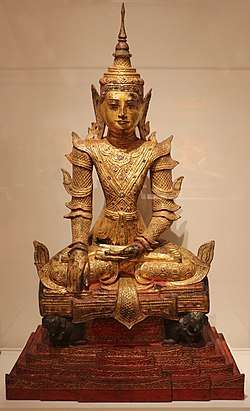Art of Myanmar
Art of Myanmar refers to visual art created in Myanmar (Burma). From the 1400s CE, artists have been creating paintings and sculptures that reflect the Burmese culture.[1] Burmese artists have been subjected to government interference and censorship, hindering the development of art in Myanmar.[2] Burmese art reflects the central Buddhist elements including the mudra, Jataka tales, the pagoda, and Bodhisattva.[3]

History
From 1962 to 1988, during the Cold War era, postcolonial Myanmar was isolated from the rest of the world as a way to maintain independence.[2] In 1989, Myanmar began to open international trade and state control was relaxed. This allowed Myanmar's artists more opportunities to engage with international artists.[2] In 1997, access to the internet allowed a contemporary art community in Myanmar to grow.[2] However, government censorship, conflict, economic hardship and isolation have affected Myanmar artists and their art. For instance, the government restricted art to religious depictions and expressions of the natural beauty of the nation.[2]
Government censorship
The government of Myanmar banned or confiscated artwork on prohibited subjects censored art exhibitions. The prohibited subjects included political criticism, nudity and even the use of certain colours. In 1970, censors defaced unapproved artworks with stamps reading "not allowed to show" on the front and back.[4] Approved paintings depicted the political leader Ne Win (1910 – 2002), socialism and its agrarian utopia, the purity of Burmese culture and Buddhism.[4] Some artists became defiant of the censorship.
Notable Burmese artists
- Director Win Pe (Burmese: ဝင်းဖေ), a cartoonist, painter and film director, worked for the Ludu Kyi-bwa-yay Press in Mandalay.[4] His work was censored by the government. Win Pe said, "The military wanted to be sure of themselves, their security… that there was no direct assault against them through art."[4]
- Aung Khaing — Khaing was a semi-abstract painter.[4] In 1984, at the Bogyoke Aung San Market, Khaing attempted his first solo exhibition of works influenced by those of Gauguin and Monet.[4] During his exhibit, government censors visited him on three separate occasions. During the first few visits, the censors removed around thirty paintings they deemed inappropriate. On the final visit, all remaining artworks left on display were deemed unacceptable to be viewed.[4] In protest, Khaing no longer displayed his paintings.[4] However, in October 2013 at the Bogyoke Aung San Market, he held a solo exhibit.
- Maung Theid Dhi — During a more severe period of art censorship in Burma, Maung was arrested for not complying with censors' orders to alter his artwork.[4] In 1974, at the Wild Eye Art Exhibition in Yangon, Maung exhibited a self-portrait on wood surrounded by a metal chain. Government censors interpreted this piece as a criticism of government restriction of Burmese life.[4] Almost immediately censors removed Maung’s work from the exhibit.[4] The censors allowed Maung to retrieve the painting later. However, when it was returned, the work was missing its original adornments.[4] Maung later put the same piece in another exhibit, but this time, he wrapped it with leather and rope and placed it atop the skull of a deer.[4] Soon after displaying his “new” art piece, censors arrested him without explanation and Maung spent a week in jail.[4] After his release, Maung continued to exhibit the same piece. As a result, censors and detectives arrived at his home accusing him of creating political artworks.[4] Several such visits caused Maung and his family great distress.[4] Maung was arrested again for his “suspicious” artworks.[4] Such distress left Maung too afraid to create paintings based on his political sketches but he did create paintings depicting the censors.
Art of the Shan Period
Art historians do not have an agreed-upon definition of Shan art. It is believed to have originated between 1550 and 1772 CE, which was around the time that the two kingdoms of Lanna and Lan Xang were both under the support of the Burmese.[1]
Many pieces of Shan artwork depict a Buddha in a seated position, with his right hand pointed towards the Earth; this position is commonly known as the Maravijaya Posture.[1] In Buddhism, the Maravijaya pose represents Buddha calling the Earth Goddess to witness Gautama Shakyamuni’s victory over Mara.[1]
Sculptures made in this art style were usually made of bronze and later would be sculpted with wood or in lacquer.[1] Traditional Shan art typically had a Buddha with the characteristic monk's robes, or adorned with a crown and decorated with various other mediums like putty and glass.[1]
Shan sculptures are distinctive and easily recognizable when looking through the history of Burmese Buddhist art.[1] Shan sculptures are often identified with oval shaped faces, soft smiles, and closed relaxed eyes.[1]
References
- Raymond, Catherine (1 May 2009). "Shan Buddhist Art on the Market: What, Where and Why?" (PDF). Contemporary Buddhism. 10 (1): 141–157. doi:10.1080/14639940902916219.
- Ching, Isabel (1 July 2011). "Art from Myanmar: Possibilities of Contemporaneity?". Third Text. 25 (4): 431–446. doi:10.1080/09528822.2011.587688.
- "Introduction and history of Buddhism & Burmese Art in Burma". www.burmese-buddhas.com. Retrieved 2017-08-03.
- Carlson, Melissa (2016). "Painting as Cipher: Censorship of the Visual Arts in Post-1988 Myanmar". Sojourn. 31 (1): 116. doi:10.1353/soj.2016.0001.